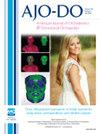采用眼动追踪技术和视觉模拟量表评价边线型清晰对准器对美感的影响
IF 3
2区 医学
Q1 DENTISTRY, ORAL SURGERY & MEDICINE
American Journal of Orthodontics and Dentofacial Orthopedics
Pub Date : 2025-07-24
DOI:10.1016/j.ajodo.2025.03.007
引用次数: 0
摘要
本研究旨在利用眼动追踪技术和视觉模拟量表,比较不同边缘处理的透明对准器对不同专业患者审美感知的影响。方法在牙龈边缘设计三种不同的边线:短扇形、直形和直形延伸。设计的矫正器在没有牵开器的情况下在黑暗的环境中使用软盒。准备好的图像通过谷歌Docs文档服务转化为一项调查。根据5分李克特量表对审美成功的调查通过在线渠道发送给参与者。眼动追踪也可以通过Sticky(版本1.4,Tobii Pro Lab;Tobii Technology AB, Danderyd, Sweden), Tobii X2-60眼动追踪软件的在线形式。本研究获得的数据使用SPSS软件(version 22;IBM,阿蒙克,纽约州)。采用Mann-Whitney U检验和Kruskal-Wallis H检验,并进行Bonferroni校正。结果各专科间得分差异无统计学意义(P >0.05)。在男性和女性受试者中,所有表面在注视次数、访问次数和观看时间上都显示出显著差异。此外,区域2在注视次数、访问次数和被注意时间上存在显著差异(P <0.05)。在男性中,区域3在注视次数、访问次数和观看时间上显示出显著差异(P <0.05)。女性的注意时间差异也有统计学意义(P <0.05)。在男性和女性受试者中,第4区在注视次数、访问次数和观看时间上显示出显著差异(P <0.05)。结论采用常规调查方法,各专科间无统计学差异。扇贝形和笔直的线条通常被注意到。本文章由计算机程序翻译,如有差异,请以英文原文为准。
Evaluation of the effect of trimline types of clear aligners on esthetic perception using eye-tracking technology and visual analog scale
Introduction
This study aimed to compare the impact of clear aligners with different edge finishes on esthetic perception across various specialties, using eye-tracking technology and the visual analog scale.
Methods
Three different trimlines are designed at the gingival border: short scallop, straight, and straight extended. The designed aligners were taken in the mouth without a retractor, in a dark environment with a softbox. The prepared images were turned into a survey via the Google Docs document service. The survey questioning esthetic success according to a 5-point Likert scale was sent to the participants via the online channel. Eye tracking will also take place online with Sticky (version 1.4, Tobii Pro Lab; Tobii Technology AB, Danderyd, Sweden), the online form of the Tobii X2-60 eye-tracking software. The data obtained in this study were analyzed using the SPSS software (version 22; IBM, Armonk, NY). Mann-Whitney U test and Kruskal-Wallis H test with Bonferroni correction were used.
Results
No significant difference was observed among the specialties in terms of scores (P >0.05). In both male and female subjects, all surfaces showed significant differences across trimlines for the number of fixations, number of visits, and time viewed. In addition, Region 2 exhibited significant differences in the number of fixations, number of visits, and time until noticed (P <0.05). In males, region 3 showed significant differences across trimlines for the number of fixations, number of visits, and time viewed (P <0.05). In females, time until noticed also differed significantly (P <0.05). In both male and female subjects, region 4 showed significant differences across trimlines for the number of fixations, number of visits, and time viewed (P <0.05).
Conclusions
No differences were found among the specialty groups using the conventional survey method. Scalloped and straight trimlines were generally noticed.
求助全文
通过发布文献求助,成功后即可免费获取论文全文。
去求助
来源期刊
CiteScore
4.80
自引率
13.30%
发文量
432
审稿时长
66 days
期刊介绍:
Published for more than 100 years, the American Journal of Orthodontics and Dentofacial Orthopedics remains the leading orthodontic resource. It is the official publication of the American Association of Orthodontists, its constituent societies, the American Board of Orthodontics, and the College of Diplomates of the American Board of Orthodontics. Each month its readers have access to original peer-reviewed articles that examine all phases of orthodontic treatment. Illustrated throughout, the publication includes tables, color photographs, and statistical data. Coverage includes successful diagnostic procedures, imaging techniques, bracket and archwire materials, extraction and impaction concerns, orthognathic surgery, TMJ disorders, removable appliances, and adult therapy.

 求助内容:
求助内容: 应助结果提醒方式:
应助结果提醒方式:


